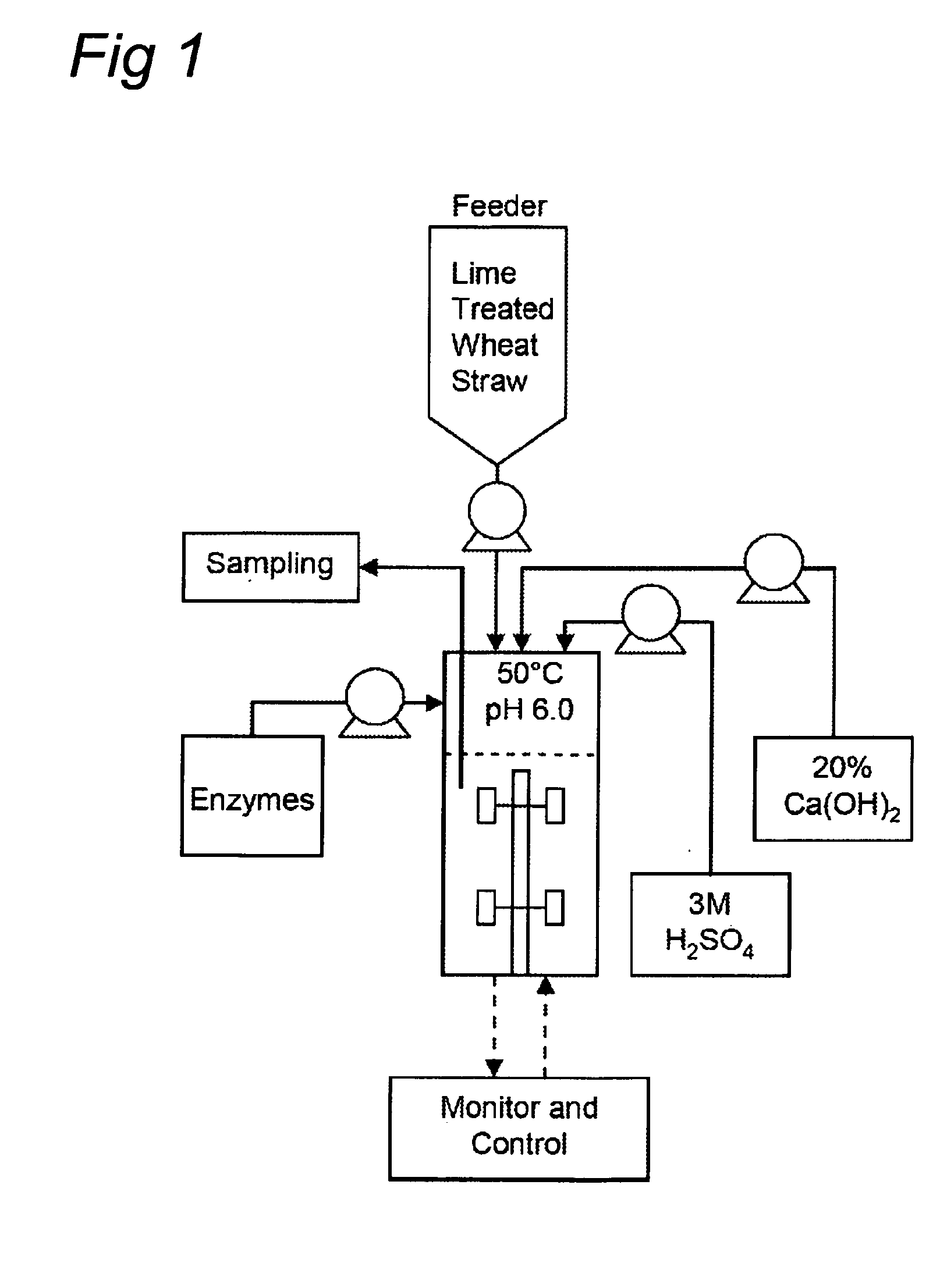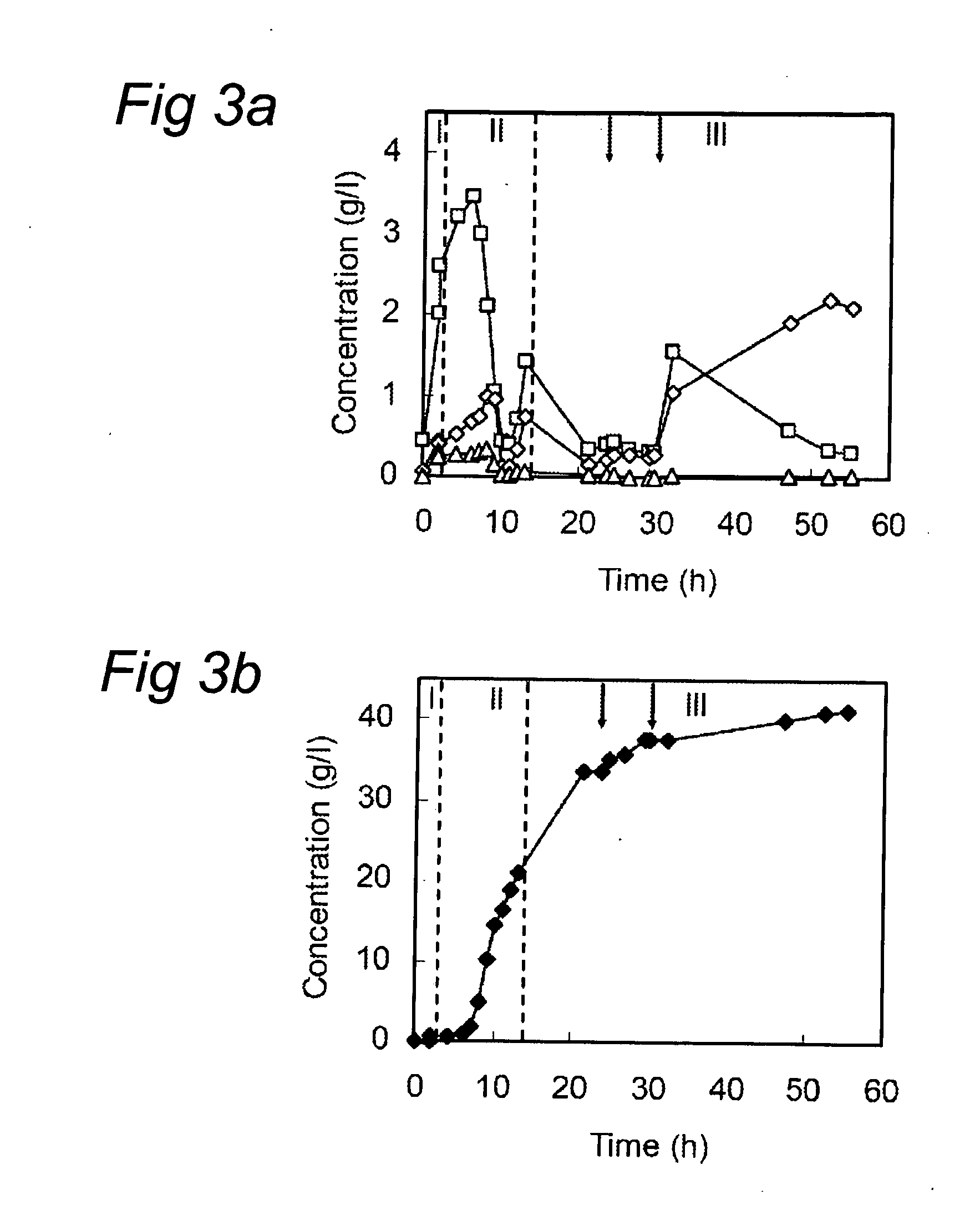Mild alkaline pretreatment and simultaneous saccharification and fermentation of lignocellulosic biomass into organic acids
a technology of lignocellulosic biomass and simultaneous saccharification, which is applied in the direction of biomass after-treatment, specific use bioreactors/fermenters, enzyme production/based bioreactors, etc., can solve the problems of low value salt formation, high water consumption, and relatively high ph value of alkaline pretreatmen
- Summary
- Abstract
- Description
- Claims
- Application Information
AI Technical Summary
Benefits of technology
Problems solved by technology
Method used
Image
Examples
example 1
Feedstock and Pretreatment
[0059]Wheat straw was selected as lignocellulose model feedstock and was purchased from a farm in the Northeast of the Netherlands. The wheat straw was air dry (89.5% (w / w) dry matter) and ground through a 2-mm screen. The lime pretreatment was performed by filling two 15 l mixers (Terlet, The Netherlands), both with 1650 g ground wheat straw, 13 kg tap water and 165 g calcium hydroxide. This wheat straw suspensin was heated and kept at 85° C. for 16 hours under continuously stirring at 30 rpm. The lime-treated wheat straw (LTWS) suspension was subsequently cooled to 30° C., dehydrated by placing the LTWS in a cotton bag, and pressing the suspension using a manual piston press at pressure up to 9.7 kg / m2. After dehydration, an amount of 11.45 kg LTWS with an average dry matter content of 27.0% (w / w) and pH 11.8 was obtained and served as substrate for further experiments. The chemical composition of LTWS was determined as described by van den Oever et al. (...
example 2
Enzyme Preparation
[0060]The enzyme preparation GC 220 (Genencor-Danisco, Rochester, USA) containing cellulase, cellobiase and xylanase activity of 116, 215 and 677 U / ml respecively, (Kabel et al (2006) Biotechnol. Bioeng. 93(1):5663) and was used for this study. The preparation had a specific gravity of 1.2 g / ml and contained 4.5 mg / ml glucose, 2.9 mg / ml mannose and 0.8 mg / ml galactose.
example 3
Micro-Organism and Pre-Culture
[0061]The bacterium Bacillus coagulans strain DSM 2314(available at the DSMZ—Deutsche Sammlung von Mikroorganismen and Zellkulturen GmbH, Inhoffenstraβe 7 B, 38124 Braunschweig, Germany) was used as lactic acid-producing micro-organism. Bacterial cells were maintained in a 10% (w / w) glycerol stock solution and stored at −80° C. Chemicals, unless indicated otherwise, were purchased from Merck (Darmstadt, Germany). Gelrite plates were prepared with medium containing (per liter) glucose, 10 g; Gelrite, 20 g (Duchefa, Haarlem, The Netherlands); yeast extract, 10 g (Duchefa); (NH4)2HPO4, 2 g; (NH4)2SO4, 3.5 g; BIS-TRIS, 10 g (USB, Ohio, USA); MgCl2.6H2O, 0.02 g and CaCl2.2H2O, 0.1 g. Glucose and Gelrite were dissolved in stock solution A (4 times concentrated). The pH of this stock solution was adjusted to 6.4 with 2M hydrochloric acid and autoclaved for 15 min at 125° C. The remaining nutrients were dissolved in stock solution B (1.33 times concentrated) wh...
PUM
| Property | Measurement | Unit |
|---|---|---|
| pressure | aaaaa | aaaaa |
| temperature | aaaaa | aaaaa |
| temperature | aaaaa | aaaaa |
Abstract
Description
Claims
Application Information
 Login to View More
Login to View More - R&D
- Intellectual Property
- Life Sciences
- Materials
- Tech Scout
- Unparalleled Data Quality
- Higher Quality Content
- 60% Fewer Hallucinations
Browse by: Latest US Patents, China's latest patents, Technical Efficacy Thesaurus, Application Domain, Technology Topic, Popular Technical Reports.
© 2025 PatSnap. All rights reserved.Legal|Privacy policy|Modern Slavery Act Transparency Statement|Sitemap|About US| Contact US: help@patsnap.com



